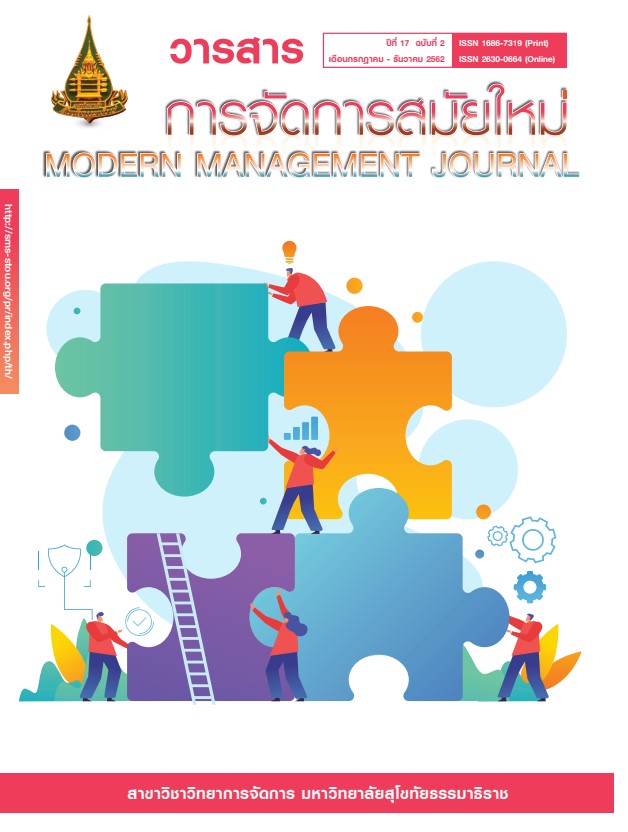ANTECEDENTS AND CONSEQUENCE OF CUSTOMER ENGAGEMENT CONCEPTUAL FRAMEWORK
Keywords:
Antecedent, Consequence, Customer Engagement, Customer LoyaltyAbstract
Today's business environment is changing dynamically and focusing on high-level interactions. The role of customer engagement is to created experiences and shared values, there is a growing concern among business consultants and practitioners. Furthermore, the academic research that related to customer engagement and the study that focuses on the relationship between antecedents and consequence of customer engagement is limit. The purpose of this article is to construct a conceptual framework for the study of antecedents and consequence of customer engagement to generate engagement with customers. This will lead to profound customer loyalty and long-term occurrences.
References
Ashley, C., Noble, S. M., Donthu, N., & Lemon, K. N. (2011). Why customers won’t relate: Obstacles to relationship marketing engagement. Journal of Business Research, 64, 749-756.
Baker, J., Parasuraman, A., Grewal, D., & Voss, G. B. (2002). The influence of multiplestore environment cues on perceived merchandise value and patronage intentions. Journal of Marketing, 66(2), 120–141.
Baldus, B. J., Voorhees, C., & Calantone, R. (2015). Online brand community engagement: Scale development and validation. Journal of Business Research, 68(5), 978–985.
Bowden, J. L. (2009). The process of customerengagement: a conceptual Framework.Journal of Marketing Theory and Practice, 17(1), 63-74.
Brodie, R. J., Ilic, A., Juric, B., & Hollebeek, L. (2013). Consumer engagement in a virtual brand community: An exploratory analysis. Journal of Business Research, 66, 105-114.
Gummerus, J., Liljander, V., Weman, E., & Pihlström, M. (2012). Customer engagement in a facebook brand community. Management Research Review, 35(9), 857–877.
Harrigan, P., Evers, U., Miles, M., & Daly, T. (2017). Customer engagement with tourism social media brands. Tourism Management, 59, 597-609.
Hollebeek, L. D., Glynn M. S., & Brodie, R. J. (2014). Consumer brand engagement in social media: Conceptualization, scale development and validation. Journal of Interactive Marketing, 28(2), 149-165.
Marketing Science Institute (2006). 2006-2008 research priorities: A guide to MSI research programs and procedures. Cambridge, MA: Marketing Science Institute.
Martínez, P., & del Bosque, I. R. (2013). CSR and customer loyalty: The roles of trust, customer identification with the company and satisfaction. International Journal of Hospitality Management, 35, 89-99.
Mollen, A., & Wilson, H. (2010). Engagement,telepresence and interactivityin online consumer experience: Reconciling scholastic and managerial perspectives. Journal of Business Research, 63, 919-925.
Morgan, R. M., & Hunt, S. D. (1994). The commitment-trust theory of relationship marketing. Journal of Marketing, 58(3), 20-38.
Oliver, R. L. (1999). Whence consumer loyalty?Journal of Marketing, 63, 33-44.
Park, W. C., MacInnis, D. J., Priester, J., Eisingerich, A. B., & Lacobucci, D. (2010). Brand attachment and brand attitude strength: Conceptual and empirical differentiation of two critical brand equity drivers. Journal of Marketing, 74(6), 1-17.
Prahalad, C. K., & Ramaswamy, V. (2004). Co-creation experiences: The next practice in value creation. Journal of Interactive Marketing, 18(3), 5-14.
Rittanon, M. (2010). Customer engagement: Looking at customers through the eyesof Kotler. Brandage Essential, 4(2), 37-49. [In Thai]
Santos, C. P., & Fernandes, D. V. H. (2008).Antecedents and consequences of consumer trust in the context of service recovery. Brazilian Administration Review,5(3), 225-244.
Sashi, C. M. (2012). Customer engagement, buyer-seller relationships, and social media. Management Decision, 50(2), 253-272.
Sawhney, M., Verona, G., & Prandelli, E. (2005). Collaborating to create: The internet as a platform for customer engagement in product innovation. Journal of InteractiveMarketing, 19(4), 4-17.
Thakur, R. (2018). Customer engagement and online reviews. Journal of Retailing and Consumer Services, 41, 48-49.
Tiangtham, S. (2010). CRM-CEM important foundation to customer engagement. Brandage essential, 4(2), 72-81. [In Thai]
Tikkanen, H., Hietanen, J., Henttonen, T., &Rokka, J. (2009). Exploring virtual worlds: Success factors in virtual worldmarketing. Management Decision, 47(8), 1357-1381.
Tungpradit. W., Anurit, P., & Mualchontam, R. (2017). Building brand equity through brand personality brand image influencing buying behavior of facial care cosmetic products in Thailand. Modern Management Journal, 15(1), 161-174. [In Thai]
Van Doorn, J., Lemon, K. N., Mittal, V., Nass, S., Pick,D., Pirner, P., & Verhoef, P. C. (2010). Customer engagement behavior: Theoretical foundations and research directions. Journal of Service Research, 13(3), 253-266.
Vivek, S. D., Beatty, S. E., & Morgan, R. M. (2012). Consumer engagement: Exploring customer relationships beyond purchase. Journal of Marketing Theory and Practice, 20(2), 127-145.
Wei, W., Miao, L., & Huang, Z. (2013). Customer engagement behaviors and hotel responses. International Journal of Hospitality Management, 33, 316-330.



